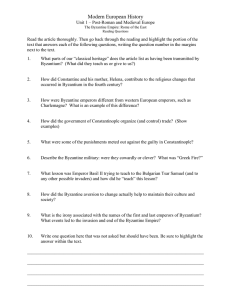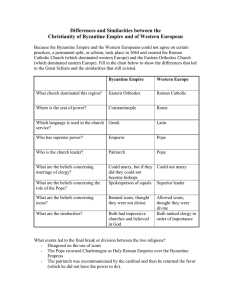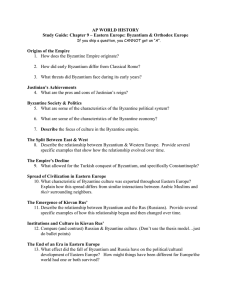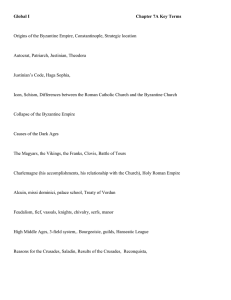Theology of the Icon. Syllabus and Bibliography. Harvard Divinity School
advertisement
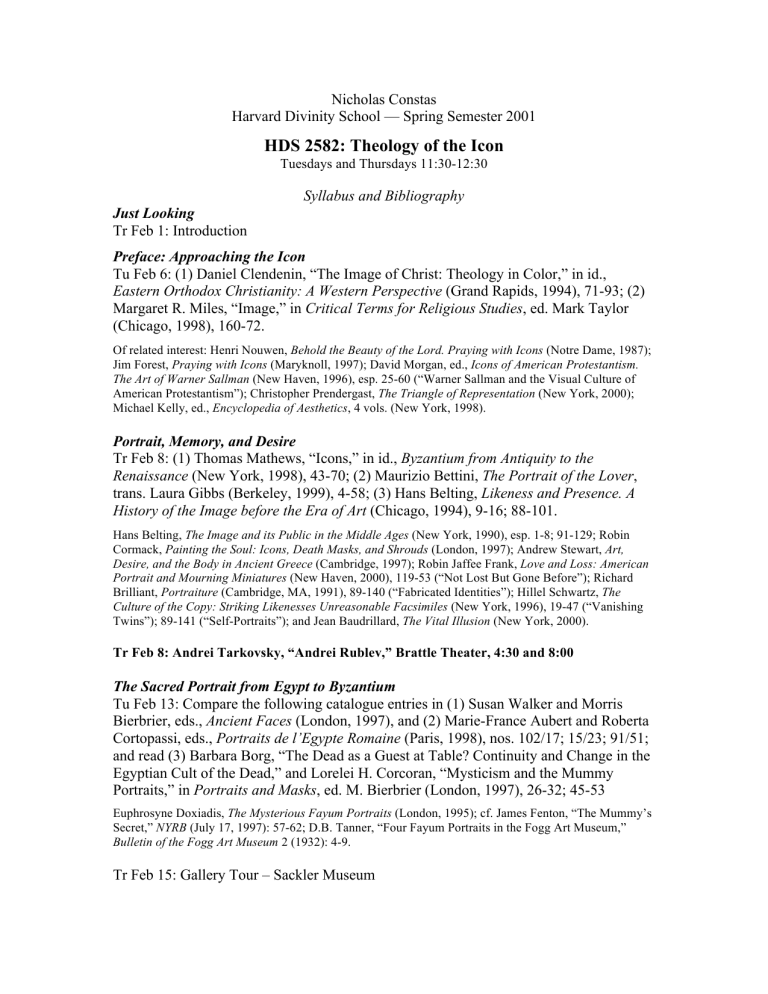
Nicholas Constas Harvard Divinity School — Spring Semester 2001 HDS 2582: Theology of the Icon Tuesdays and Thursdays 11:30-12:30 Syllabus and Bibliography Just Looking Tr Feb 1: Introduction Preface: Approaching the Icon Tu Feb 6: (1) Daniel Clendenin, “The Image of Christ: Theology in Color,” in id., Eastern Orthodox Christianity: A Western Perspective (Grand Rapids, 1994), 71-93; (2) Margaret R. Miles, “Image,” in Critical Terms for Religious Studies, ed. Mark Taylor (Chicago, 1998), 160-72. Of related interest: Henri Nouwen, Behold the Beauty of the Lord. Praying with Icons (Notre Dame, 1987); Jim Forest, Praying with Icons (Maryknoll, 1997); David Morgan, ed., Icons of American Protestantism. The Art of Warner Sallman (New Haven, 1996), esp. 25-60 (“Warner Sallman and the Visual Culture of American Protestantism”); Christopher Prendergast, The Triangle of Representation (New York, 2000); Michael Kelly, ed., Encyclopedia of Aesthetics, 4 vols. (New York, 1998). Portrait, Memory, and Desire Tr Feb 8: (1) Thomas Mathews, “Icons,” in id., Byzantium from Antiquity to the Renaissance (New York, 1998), 43-70; (2) Maurizio Bettini, The Portrait of the Lover, trans. Laura Gibbs (Berkeley, 1999), 4-58; (3) Hans Belting, Likeness and Presence. A History of the Image before the Era of Art (Chicago, 1994), 9-16; 88-101. Hans Belting, The Image and its Public in the Middle Ages (New York, 1990), esp. 1-8; 91-129; Robin Cormack, Painting the Soul: Icons, Death Masks, and Shrouds (London, 1997); Andrew Stewart, Art, Desire, and the Body in Ancient Greece (Cambridge, 1997); Robin Jaffee Frank, Love and Loss: American Portrait and Mourning Miniatures (New Haven, 2000), 119-53 (“Not Lost But Gone Before”); Richard Brilliant, Portraiture (Cambridge, MA, 1991), 89-140 (“Fabricated Identities”); Hillel Schwartz, The Culture of the Copy: Striking Likenesses Unreasonable Facsimiles (New York, 1996), 19-47 (“Vanishing Twins”); 89-141 (“Self-Portraits”); and Jean Baudrillard, The Vital Illusion (New York, 2000). Tr Feb 8: Andrei Tarkovsky, “Andrei Rublev,” Brattle Theater, 4:30 and 8:00 The Sacred Portrait from Egypt to Byzantium Tu Feb 13: Compare the following catalogue entries in (1) Susan Walker and Morris Bierbrier, eds., Ancient Faces (London, 1997), and (2) Marie-France Aubert and Roberta Cortopassi, eds., Portraits de l’Egypte Romaine (Paris, 1998), nos. 102/17; 15/23; 91/51; and read (3) Barbara Borg, “The Dead as a Guest at Table? Continuity and Change in the Egyptian Cult of the Dead,” and Lorelei H. Corcoran, “Mysticism and the Mummy Portraits,” in Portraits and Masks, ed. M. Bierbrier (London, 1997), 26-32; 45-53 Euphrosyne Doxiadis, The Mysterious Fayum Portraits (London, 1995); cf. James Fenton, “The Mummy’s Secret,” NYRB (July 17, 1997): 57-62; D.B. Tanner, “Four Fayum Portraits in the Fogg Art Museum,” Bulletin of the Fogg Art Museum 2 (1932): 4-9. Tr Feb 15: Gallery Tour – Sackler Museum 2 Tu Feb 20: Jonah Friedman: “The Currency of Portraiture.” Wed Feb 21: Celebration of Black History: The Icons of Ethiopia (Andover Chapel) A Brief History of the Byzantine Icon Tr Feb 22: (1) Gary Vikan, “Byzantine Art,” and (2) Henry Maguire, “Byzantine Art in the Second Half of the Twentieth Century,” in Byzantium: A World Civilization, ed., Angeliki E. Laiou and H. Maguire (Washington, D.C., 1992), 81-118; 119-55; (3) Kurt Weitzmann, The Icon. Holy Images: Sixth to Fourteenth Century (New York, 1978), 723. For a critique of Harnack on the beginnings of Christian art, see Paul Corbey Finney, The Invisible God. The Earliest Christians on Art (Oxford, 1994); for a helpful revision of some prevailing paradigms in the study of early Christian art, see Thomas Mathews, The Clash of Gods: A Reinterpretation of Early Christian Art (Princeton, 1993; revised and expanded, 1999). On the rise of the icon in the context of the transformation of late-antique civilization, see John Haldon, Byzantium in the Seventh Century. The Transformation of a Culture (Cambridge, 1993), 403-35; and Jas Elsner, Art and the Roman Viewer: The Transformation of Art from the Pagan World to Christianity (Cambridge, 1995). For a catalogue of lateantique religious art, see Kurt Weitzmann, The Age of Spirituality. Late Antique and Early Christian Art, Third to Seventh Century (New York, 1979). For a study of medieval Byzantine iconography, with special attention to its architectural context, see Otto Demus, Byzantine Mosaic Decoration. Aspects of Monumental Art in Byzantium (New York, 1976); for a sumptuous catalogue of medieval Byzantine art, see Helen Evans and W.D. Wixom, eds., The Glory of Byzantium: Art and Culture of the Middle Byzantine Era, A.D. 843-1261 (New York, 1997); for the Late Byzantine (Paleologan) period, see Paul Underwood, The Kariye Djami, 4 vols. (New York, 1966). For an extensive collection of primary sources, see Cyril Mango, The Art of the Byzantine Empire: Sources and Documents (Toronto, 1986); for a collection of conference papers, see Dumbarton Oaks Papers 45 (1991) = 1990 Symposium on “The Holy Icon.” For specific themes and topics, consult The Oxford Dictionary of Byzantium, 3 vols. (Oxford, 1991). God as Trinity: The Eternal Image Tu Feb 27: (1) Christoph Schönborn, God’s Human Face: The Christ-Icon (San Francisco, 1994), 3-43. Christology: The Image Incarnate Tr Mr 1: Schönborn, God’s Human Face, 45-133. “Worlds Cunningly Fashioned”: Cosmology and Anthropology Tu Mr 6, 6:00 p.m.: (1) Eric Perl, “Symbol, Sacrament, and Hierarchy in Dionysius the Areopagite,” GOTR 39 (1994): 313-44; (2) Panayiotis Nellas, “The Image of God,” in id., Deification in Christ (Crestwood, NY, 1987), 21-42; 223-25. Gerhart Ladner, “The Concept of the Image in the Greek Fathers and the Byzantine Iconoclastic Controversy,” DOP 7 (1953): 3-33; A. Altmann, “Homo imago Dei in Jewish and Christian Theology,” Journal of Religion 48 (1968): 235-59; H. Crouzel, La théologie de l’image de Dieu chez Origène (Paris, 1956); R. Bernard, L’image de Dieu d’après saint Athanase (Paris, 1952); W. Burghardt, The Image of God in Man according to Cyril of Alexandria (Washington, D.C., 1957); F. McLeod, The Image of God in the Antiochene Tradition (Washington, D.C., 1999); L. Thunberg, Microcosm and Mediator: The Theological Anthropology of Maximus the Confessor, 2nd ed. (Chicago, 1995). See also V. Lossky, “Image and Likeness,” in The Mystical Theology of the Eastern Church (Crestwood, 1976), 114-34; id., “Theology of the Image,” in In the Image and Likeness of God (Crestwood, 1974), 125-39; Paulos Mar Gregorios, The Human Presence (Amity, 1987); J. Zizioulas, “Human Capacity and Human Incapacity: A Theological 3 Exploration of Personhood,” Scottish Journal of Theology 28 (1975): 401-48; id., “From Prosopeion to Prosopon: the Contribution of Patristic Theology to the Concept of the Person,” in Charesteria: Studies in Honor of Meliton of Chalcedon (Thessaloniki, 1977), 287-323 [in Greek]; id., Being as Communion (Crestwood, 1985); “On Being a Person: Towards an Ontology of Personhood,” in Persons, Divine and Human, ed. C. Schwöbel and C. Gunton (Edinburgh, 1991), 33-46. The Senses Provoked: Iconoclasm and Aniconism Tr Mr 8: (1) Schönborn, God’s Human Face, 141-78; (2) David Freedberg, The Power of Images: Studies in the History of Theory and Response (Chicago, 1989), 378-428 (“Idolatry and Iconoclasm”); (3) Karel Van Der Toorn, “The Iconic Book: Analogies between the Babylonian Cult of Images and the Veneration of the Torah,” in The Image and the Book, ed. K. Van Der Toorn (Leuven, 1997), 229-48. Jaroslav Pelikan, “Images of the Invisible,” in id., The Spirit of Eastern Christendom (Chicago, 1974), 91133; Antony Bryer and Judith Herrin, eds., Iconoclasm (Birmingham, 1977) = a collection of important conference papers; Moshe Halbertal and Avishai Margalit, Idolatry (Cambridge, MA, 1992), 37-66; Alain Besançon, The Forbidden Image: An Intellectual History of Iconoclasm, trans. Jane Marie Todd (Chicago, 2000); Jean-Luc Marion, God Without Being (Chicago, 1991), 7-107; Charles Barber, “The Truth in Painting: Iconoclasm and Identity in Early-Medieval Art,” Speculum 72 (1997): 1019-36; Guy Stroumsa, “Form(s) of God: Some Notes on Metatron and Christ,” HThR 76 (1983): 269-88; Elliot Wolfson, Through a Speculum that Shines: Vision and Imagination in Medieval Jewish Mysticism (Princeton, 1994); Catherine Sousloff, ed., Jewish Identity in Modern Art History (Berkeley, 1999); Oleg Grabar, The Formation of Islamic Art (Yale, 1987), 72-98; Lisa Saltzman, Anselm Kiefer and Art after Auschwitz (Cambridge, 1999), 17-47; Dario Gamboni, The Destruction of Art: Iconoclasm and Vandalism since the French Revolution (London, 1997), esp. chp. 10 (“Museums and Pathology”), and chp. 13 (“Modern Art and Iconoclasm”). The Cult of Matter: John of Damascus Tu Mr 13: (1) John of Damascus, On the Divine Images, trans. David Anderson (Crestwood, 1980); (2) Schönborn, God’s Human Face, 179-235 On the Seventh Ecumenical Council (“Nicaea II,” 787), see, for a basic introduction, Leo Donald Davis, The First Seven Ecumenical Councils (325-787) (Wilmington, DE, 1987), 290-319; for selections from the conciliar acta, see Daniel Sahas, Icon and Logos (Toronto, 1986); for a close reading of the acta, see Ambrosios Giakalis, Images of the Divine. The Theology of Icons at the Seventh Ecumenical Council (Leiden, 1994), 1-21; cf. Annuarium Historiae Conciliorum 20 (1988) = fascicle dedicated to the Seventh Council (25 articles); P. Van den Ven, “La patristique et l’hagiographie au concile de Nicée de 787,” Byzantion 25 (1955/1957): 325-62; H. Ohme, “Ikonen, historische Kritik und Tradition. Das VII. Ökumenische Konzil (787) und die kirchliche Überlieferung,” Zeitschrift für Kirchengeschichte 110 (1999): 1-24. See also B. Neil, “The Western Reaction to the Council of Nicaea II,” JThS 51.2 (2000): 53352; J.R. Payton, “Calvin and the Legitimation of Icons: His Treatment of the Seventh Ecumenical Council,” Archiv für Reformationsgeschichte 83 (1993): 222-41; and Sergiusz Michalksi, The Reformation and the Visual Arts (London, 1993) . Veronica’s Veil: Gendering the Icon Tr Mr 15: (1) “The Life of St. Theodosia,” trans. Nicholas Constas, in Byzantine Defenders of Images, ed. A-M. Talbot (Washington, D.C., 1998), 1-7; (2) Robin Cormack, “Women and Icons, and Women in Icons,” in Women, Men, and Eunuchs: Gender in Byzantium, ed. Liz James (London, 1997), 24-44; (3) Ewa Kuryluk, “Mirrors and Menstruation,” Formations 1.2 (1984): 64-77. See also: “The Life of Saint Anthousa,” trans. Nicholas Constas, in Byzantine Defenders of Images, 21-24; “The Life of Saint Theodora the Empress,” trans. Martha Vinson, in Byzantine Defenders of Images, 35382; Judith Herrin, “Women and the Faith in Icons in Early Christianity,” in Culture, Ideology and Politics, 4 ed. R. Samuel and G. Stedman Jones (London, 1982), 65-83; ead., “In Search of Byzantine Women: Three Avenues of Approach,” in Images of Women in Antiquity, ed. Av. Cameron and A. Kuhrt (London, 1984), 167-89; ead., “Femina Byzantina,” DOP 46 (1992): 97-105; ead., “Private and Public Forms of Religious Commitment among Byzantine Women,” in Women in Ancient Societies. An Illusion in the Night, ed. L. Archer, et al. (London, 1994), 181-203; A.-M. Talbot and A. Kazhdan, “Women and Iconoclasm,” Byzantinische Zeitschrift 84-85 (1991-1992): 391-408; A.-M. Talbot, ed., Holy Women of Byzantium (Washington, D.C., 1996), esp. x-xv; ead., “Women,” in The Byzantines, ed. G. Cavallo (Chicago, 1997), 117-43; Lynda Garland, “The Life and Ideology of Byzantine Women,” Byzantion 58 (1988): 361-93; G. Huxley, “Women and Byzantine Iconoclasm,” in Les femmes et le monachisme byzantin, Publications of the Canadian Archeological Institute in Athens, no. 1, ed. J.Y. Perrault (Athens, 1991): 11-24; Peter Hatlie, “Women of Discipline during the Second Iconoclastic Age,” BZt 89 (1996): 37-44; K.M. Ringrose, “Living in the Shadows: Eunuchs and Gender in Byzantium,” in Third Sex, Third Gender. Beyond Sexual Dimorphism in Culture and History, ed. G. Herdt (New York, 1994), 85-109; Judith M. Benneth, “Medievalism and Feminism,” Speculum 68 (1993): 309-31; G. Pollock, Vision and Difference: Femininity, Feminism and the Histories of Art (London, 1988); and Diane Apostolos-Cappadona, Encyclopedia of Women in Religious Art (New York, 1996). Tr March 15: Professor Robert Gimello, “Buddahood Envisaged, Buddahood Inscribed: Notes toward a Buddhist Iconology,” with responses by Donald Swearer and Nicholas Constas (Sperry, 5:15 p.m.) Facing Infinity: Emmanuel Levinas and Jean-Luc Marion Tu Mr 20: (1) Emmanuel Levinas, Totality and Infinity (The Hague, 1979), 187-247; (2) Jean-Luc Marion, “The Face: An Endless Hermeneutics,” Harvard Divinity Bulletin 28, no. 2/3 (1999): 9-10. Paul Davies, “The Face and the Caress: Levinas’ Ethical Alterations of Sensibility,” in Modernity and the Hegemony of Vision, ed. David Michael Levin (Berkeley, 1993), 252-72; Luce Irigaray, “The Fecundity of the Caress,” in Face to Face with Levinas, ed. Richard Cohen (Albany, NY, 1986); Cathryn Vasseleu, “Illuminating Passion: Irigaray’s Transfiguration of Night,” in Vision in Context: Historical and Contemporary Perspectives on Sight, ed. Teresa Brennan and Martin Jay (New York and London, 1996), 129-37; Alphonso Lingis, “The Sensuality and the Sensitivity,” in Face to Face with Levina, 219-30; Richard Cohen, “The Face of Truth in Rosenzweig, Levinas, and Jewish Mysticism,” in Phenomenology of the Truth Proper to Religion, ed. Daniel Guerrière (Albany, NY, 1990); James Ponet, “Faces: A Meditation,” Orim 1 (1985): 58-76; and J. Cole, About Face (Cambridge, MA, 1999). Eschatological Bodies and Spiritual Senses Tr Mr 22: Nicholas Constas, “Icons and the Imagination,” Logos 1.1 (1997): 114-27. Susan Ashbrook Harvey, “The Stylite’s Liturgy: Ritual and Religious Identity in Late Antiquity,” JECS 6.3 (1998): 523-39; Henry Maguire, “Disembodiment and Corporeality in Byzantine Images of Saints,” in Iconography at the Crossroads, ed. B. Cassidy (Princeton, 1993), 75-83; id., The Icons of their Bodies. Saints and their Images in Byzantium (Princeton, 1996); Glenn Peers, Subtle Bodies: Representing Angels in Byzantium (Berkeley, 2001); Herbert Kessler, The Holy Face and the Paradox of Representation (Bologna, 1998); P. Magli, “The Face and the Soul,” in Fragments for a History of the Human Body, ed. M. Feher (New York, 1989), 87-127; T. Shaw, “Askesis and the Appearance of Holiness,” JECS 6 (1998): 485-99; H.P. L’Orange, Apotheosis in Ancient Portraiture (Cambridge, MA, 1947); G. Simon, Le regard, l’être, et l’apparence dans l’optique de l’antiquité (Paris, 1988); P. Zanker, The Mask of Socrates: The Image of the Intellectual in Antiquity (Berkeley, 1995); M. Gleason, Making Men: Sophists and SelfRepresentation in Ancient Rome (Princeton, 1995). Tu Mr 27 -Tr Mr 29: Spring Recess 5 Space and Form, Light and Color Tu Ap 3: (1) Gary Gurtler, “Plotinus and Byzantine Aesthetics,” The Modern Schoolman 66 (1989): 275-84; (2) Pavel Florensky, “Against Linear Perspective,” in Utopias, ed. Catriona Kelly (London, 1999), 70-75; (3) Liz James, Light and Color in Byzantine Art (Oxford, 1996), 91-109; (4) John Gage, Color and Culture: Practice and Meaning from Antiquity to Abstraction (Berkeley, 1993), 39-64; (5) Marie-José Baudinet, “The Face of Christ: Form of the Church,” in Fragments for a History of the Human Body, ed. Michel Feher (New York, 1989), 149-159. Egon Sendler, The Icon: Image of the Invisible. Elements of Theology, Aesthetics, and Technique (Redondo Beach, CA, 1988). The classic, and contested, work on perspective remains that by Erwin Panofsky, Perspective as Symbolic Form (Leipzig and Berlin, 1927; New York, 1991); cf. Hubert Damisch, The Origin of Perspective (Cambridge, MA, 1994). For a symbolist reading of space, see Gaston Bachelard, The Poetics of Space (Boston, 1994); for the postmodern, Henri Lefebvre, The Production of Space (Oxford, 1993); cf. Maurice Blanchot, The Space of Literature, trans. Ann Smock (Lincoln, 1982); and B. Bokser, “Approaching Sacred Space,” HThR 78 (1985): 279-99. On Byzantine aesthetics, see Gervase Mathew, Byzantine Aesthetics (New York, 1963); P. Michelis, An Aesthetic Approach to Byzantine Art (London, 1955); V. Bychkov, Vizantiiskaia estetika (Moscow, 1977). See also David Batchelor, Cromophobia (London, 2000); John Gage, Color and Meaning: Art, Science, and Symbolism (Berkeley, 1999); D.E. Hahm, “Early Hellenistic Theories of Vision and the Perception of Color,” in Studies in Perception: Interrelations in the History of Philosophy and Science, ed. P.K. Machamer and R.G. Turnbull (Columbus, 1978), 60-95; G. Scholem, “Colours and their Symbolism in the Zohar,” Diogenes 108 (1979): 84-111; 109 (1980): 64-76; Elaine Scarry, On Beauty and Being Just (Princeton, 1999). Tr Ap 5: Jonah Friedman: Color Tu Ap 10: Richard Avedon, “Darkness and Light” Tr Ap 12: The Christological Cycle Archimandrite Vasileios, “The Icon as Liturgical Analogy,” in his Hymn of Entry, trans. Elizabeth Briere (Crestwood, NY, 1984), 81-88. For explanations of the major iconographic types and programs, see Leonid Ouspensky and Vladimir Lossky, The Meaning of Icons (Crestwood, NY, 1983); Constantine Cavarnos, Guide to Byzantine Iconography (Boston, 1993); John Baggley, Festival Icons for the Christian Year (Crestwood, NY, 2000). See also John Drury, Painting the Word: Christian Pictures and their Meanings (New Haven, 1999). Monday, April 16: Professor Alexei Lidov, “The Iconostasis: Development and Symbolic Interpretation” (Sackler Museum, 4:00 p.m.) Annunciation: The Thread of Life Tu Ap 17: (1) Nicholas Constas, “Weaving the Body of God: Proclus of Constantinople, the Theotokos, and the Loom of the Flesh,” JECS 3.2 (1995): 169-94; (2) Leonid Ouspensky and Vladimir Lossky, The Meaning of Icons (Crestwood, NY, 1983), 172-73; (3) Constantine Cavarnos, Guide to Byzantine Iconography (Boston, 1993), 125-30. The Wounded Mother Tr Ap 19: (1) Chrysanthe Baltoyianni, Icons: The Mother of God in the Incarnation and the Passion (Athens, 1994), 17-21; 79-85; 105-112; 131-34; (2) Ouspensky and Lossky, Meaning of Icons, 168-69; (3) Cavarnos, Guide, 141-45; (4) Henry Maguire, “The 6 Iconography of Symeon with the Christ Child in Byzantine Art,” DOP 34-35 (19801981): 261-69. Tu Ap 24: (1) Julia Kristeva, “Stabat Mater,” in ead., Tales of Love, trans. Leon S. Roudiez (New York, 1987), 234-63. Tr Ap 26: (1) Ioli Kalavrezou, “The Maternal Side of the Virgin,” and (2) Maria Vassilaki and Niki Tsironis, “Representations of the Virgin and their Association with the Passion of Christ,” in Mother of God: Representations of the Virgin in Byzantine Art, ed. M. Vassilaki (Athens, 2000), 41-45; 453-63. Pop Goes the Icon Tu May 1: (1) Jane Dillenberger, The Religious Art of Andy Warhol (New York, 1998). Raymond Herbenick, Andy Warhol’s Religious and Ethnic Roots: the Carpatho-Rusyn Influence on His Art (New York, 1997). For disjunctive readings of Warhol’s Jackie, cf. Richard Brilliant, Portraiture (Cambridge, MA, 1991), 134-37, and Keith Tester, Media, Culture and Morality (London and New York, 1994), 107-30. Take a virtual tour of the Andy Warhol Museum: www.clpgh.org/warhol/tour Tr May 3: Gallery Tour: Fogg Art Museum, Harvard University Professor Nicholas Constas HDS 2582/REL 1432; Spring 2001 Office: Divinity Hall 313 Office hours by appointment; please call the Theology Office at 495-4518 Teaching Fellow: Christopher Row, Ph.D.; please arrange appointments directly Requirements (1) attend lectures; (2) read thoroughly and analyze critically all the assigned texts; (3) attend and participate in section; (4) a take-home mid-term due in class on Tuesday, March 13th; (5) an 8-10 page paper dealing with the texts and themes listed under April 19th, 24th, and 26th, due in class on Tuesday, April 24th; (6) a final essay (ca. 5 pages) of synthesis and imagination articulating a theology of the icon, due before 5:00 p.m. on Monday, May 21st Texts: a reader is available for purchase, along with a number of books available in the bookstore Website: This course is part of a Harvard-wide pilot project that uses web tools developed by FAS for the presentation of course materials. We will use several of these tools in this course, including an online syllabus, web links, and a slide carousel. The slide carousel will enable you to review images shown in lectures, along with additional information about them. Information about accessing the site will be made available during the second week of class.
